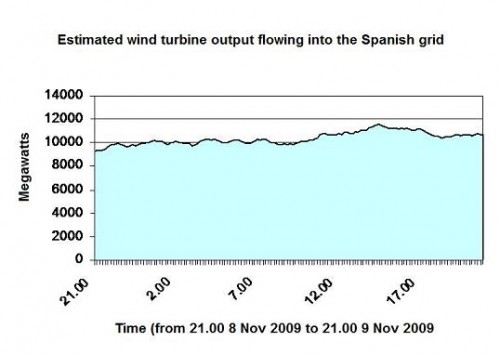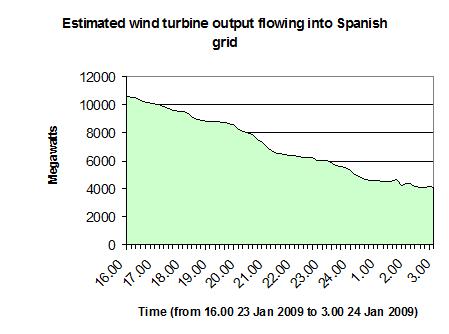Spain?s variable wind and stable electricity networks
16 Nov, 2009 11:58 pm
One of the frequent criticisms of wind energy is that national distribution systems (?the grid?) cannot cope with large number of turbines because of the variability and unpredictability of their output. Grids need to match supply and demand precisely, the critics say, and because wind varies so much it causes huge problems. Recent data from two meteorologically unusual days in Spain ? the world leader in the management of renewable energy supplies ? shows this assertion is almost certainly false.
 |
- During part of 8 November, Spain saw over 50% of its
electricity come from turbines as an Atlantic depression swept over
the country’s wind parks. (They are so big that no one seems to
call them ‘farms’.) Unlike similar times in November 2008, when
Spanish turbines were disconnected because the grid had an excess of
electricity, the system accepted and used all the wind power that
was offered to it.
- A very different event in January of this year saw
unexpectedly high winds shut down most of the country’s turbines
with little warning. The grid coped with this untoward incident as
well. These two events show that a well run transmission system can
cope with extreme and unexpected events even with a large fraction
of power provided by wind.
53% from wind
At some periods on the night of 8/9 November, wind provided 53% of Spain’s need for electricity. This was a new record for the Spanish system. As the country continues to install thousands of new wind turbines a year, this record will not stand for long.
Although Denmark has had similar percentages of its electricity provided by wind, the Spanish numbers are particularly significant. As its electricity transmission company, Red Eléctrica de España or REE, reminds us, the country is unusually isolated from international interconnections. It is ‘a peninsula electrically speaking, with weak electrical interconnections with the European Union’.[1] A country with limited capacity to import or export power has more issues accommodating large amounts of wind power. Denmark has international connections to cover 50% of its electricity while Spain has less than a tenth this amount. (The UK also scores extremely poorly on this dimension.) Spain is able to manage the integration of wind power into its grid primarily because it has reasonable amounts of hydro-electricity and pumped storage.[2] Hydro-electricity can be used when winds are less than expected and pumped storage can assist both when wind is unexpectedly high or unexpectedly low.
One of the main criticisms levelled at wind is that its power is so unpredictable that huge amounts of fossil fuel generating capacity needs to be kept ready to replace it at a moment’s notice. Those antagonistic to wind believe that the carbon cost of keeping power stations in a state of what the industry calls ‘spinning reserve’ is enormous. Power stations, they say, are burning fuel so that they can instantaneously start producing electricity if and when the wind drops.
But is wind so variable that power stations need to provide immediate backup? The utterly superb REE web site provides easy-to-use data to test this theory. I’ve used this data to try to demonstrate that wind production was remarkably consistent during the peak day of 8 November.[3] Not only is wind speed largely predictable with good meteorology, but REE data shows that even in the windy days of early November, the amount of electricity generated only varied gradually.
During this 24-hour period the total generated varied from about 9.3 gigawatts (9,300 megawatts) at the start, to a peak of around 11.5 gigawatts at about 14.30 in the afternoon. For most of the day, the wind output was very stable around 10 gigawatts. (The wind output estimate is provided every ten minutes on the REE website.) The mean percentage variation from one reading to the next was 0.72%. On only three occasions out of 143 observations did the output vary more than 2% between two readings.
 |
When the wind is blowing strongly, any local variations in wind speeds tend to be balanced out by compensating changes elsewhere. A country like Spain, with over ten thousand turbines spread across a large landmass, will have low variability of electricity output from wind. As a country adds wind turbines, the degree of variability in electricity output will tend to fall. In Spain, the variations on 8/9 November represented no threat to the stability of the electricity system, even when wind was meeting half of total power demand.
Unforeseen events
The 8/9 November peak was predicted by REE. 23 January 2009 was very different. The Spanish grid was expecting very high winds from Atlantic Storm Klaus and projections were for the country’s turbines to produce about 11 gigawatts (11,000 megawatts) of electricity for most of the 23rd and the night of 23/24.
It didn’t quite turn out that way. Wind speeds were unexpectedly low on the morning of the 23rd and electricity output hovered around 9.5 gigawatts. As wind speeds rose output began to rise from about midday and peaked at about 16.00. By that time the winds were sufficiently strong to trigger automatic shut-down of many turbines in the north of the country. (The technical term for this is ‘over-speed protection’ and means the turbines cease to provide any electricity at all.) The grid hadn’t predicted this and the amount of wind power began to fall far short of what it was expecting. By 21.00 wind generation had fallen to about 7 gigawatts (7,000 megawatts), almost 4 gigawatts below the prediction for that time. Output continued falling throughout the night and only began to recover early next morning.
At the moment of minimum output (about 06.30 on the 24th), the gap between the forecast and actual wind turbine production exceeded 7 gigawatts, or the equivalent of four or five large coal-fired power stations.
This event was unusual in two separate ways. First, it was extreme. I haven’t obtained detailed records for Spain but the grid says that some wind parks experienced winds of up to 220 km/h or about 150 miles per hour. French evidence suggests that Atlantic Storm Klaus produced the most destructive winds experienced in the south-west of the country – the part just north of northern Spain – for ten years. Some French areas reported a loss of one third of all trees in some forests.
Second, the severity was not predicted. The grid was expecting very high levels of output but did not think that the speeds would reach the level that forced turbines into automatic shut-down. The combination of these two factors produced almost the most difficult imaginable set of circumstances for an electricity transmission system: wind was expected to provide a large fraction of all electric power but this electricity suddenly became unavailable. If this Spanish electricity system could manage this, it could survive almost all problems that renewable generating plants could throw at it.
And survive it did. The control centre ramped up the supply of hydro-electric power, including pumped storage, and temporarily imported power through international connections. Within a few hours of the storm’s unexpectedly powerful arrival, the system was back in equilibrium and began to export its power again by 22.00 on the 23rd, well before the period of minimum wind output. Coal- and gas-fired power stations ran hard until about 23.00 and then fell away as total demand declined during the night.
The crucial thing about wind is that it usually fades gracefully, even in extremely severe circumstances such as Klaus. Below is a chart that shows total output from Spain’s 15 or so gigawatts of wind turbines, spread across the country but concentrated along the Atlantic coasts from Vigo northwards. You will see that the decline during the passage of Klaus is almost a straight line, with only minor unexpected bumps. By 03.00, the position is beginning to stabilise. The chart logs estimated wind output every ten minutes and in only two of the 65 ten-minute periods did output fall by more than 5%.
 |
The maximum loss of power in any ten minutes was about 450 MW and this occurred quite late in the course of the storm, when the control room was already directing surplus electricity back into pumped storage reservoirs. The control could instantaneously reduce the amount of power being sent to pump water into high reservoirs in response to the few cases of sharp declines in wind turbine availability.
The lesson from this event is profoundly cheering. The Spanish electricity system was expecting up to about 45% of its power on the night of 23/24 January to come from wind. The outturn was about 16% for most of the night. The system handled the problem with no outages.
The implications of these two events for European wind power
Those that oppose wind power, particularly in Britain, say that wind is so unreliable as to be useless. They parade a vision of gas-powered power stations generating spare electricity just in case the wind suddenly drops. The reduction in carbon emissions is negligible, they claim, and the cost of installing turbines is huge.
None of this is true. The Spanish case histories in this article show that good grid management can integrate very large amounts of wind energy with few problems, provided that pumped storage and hydraulic power can be used for storage and international connections enable easy export and import. Second, the carbon emissions from Spanish electricity production during the peak hours of 8/9 November are calculated by REE at about 145 grammes per kilowatt hour, about a quarter of typical UK electricity. Using wind power in large volumes substantially reduces the carbon dioxide produced in electricity generation.
What about the cost of the wind electricity? The Spanish system pays wind park owners €75 per megawatt hour under most conditions and a maximum of about €90 when the overall power market is trading electricity at unusually high prices. For comparison, this is considerably less than is typically paid to UK wind farm operators from wholesale sales of power and from the supplementary value of renewable electricity credits.
The Spanish system is therefore a) improving the country’s energy security, b) reducing carbon emissions, c) costing less per MWh than the British support system, and d) incentivising the introduction of continuing huge numbers of extra wind turbines. Other countries have a lot to learn from Spain.
Footnotes
[1] Presentation to the MIT Energy Club, ‘Wind energy development in Spain’, delivered by Luis Atienza, Chairman and CEO of REE on 3 April 2009.
[2] Pumped storage reservoirs release water through turbines when power is needed. The water flows into a lower reservoir. When electricity is prospectively in surplus, the water is pumped back into the upper reservoir. These systems can usually produce electricity within a half minute of being instructed. Big reservoirs can produce gigawatts of power, but usually only for a number of hours, not days. They are particularly useful at protecting against the unexpected shutdown of large fossil fuel or nuclear stations, which can occur (although rarely) within no warning whatsoever.
[3] The REE system now monitors most individual turbines in real time. This certainly isn’t the case on other grids. Data is immediately visible on http://www.ree.es/operacion/curvas_demanda.asp (Spanish language).
Originally published on Carbon Commentary
-
12/12/12
“Peak Oil” is Nonsense… Because There’s Enough Gas to Last 250 Years.
-
05/09/12
Threat of Population Surge to "10 Billion" Espoused in London Theatre.
-
05/09/12
Current Commentary: Energy from Nuclear Fusion – Realities, Prospects and Fantasies?
-
04/05/12
The Oil Industry's Deceitful Promise of American Energy Independence
-
14/02/12
Shaky Foundations for Offshore Wind Farms






